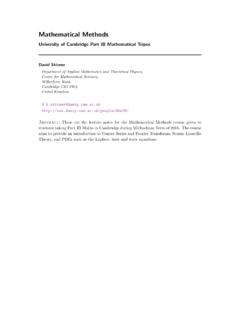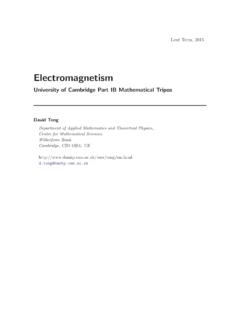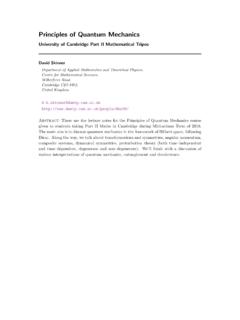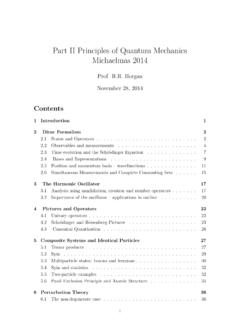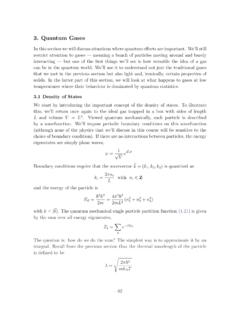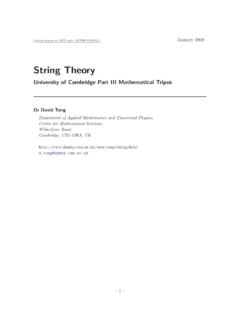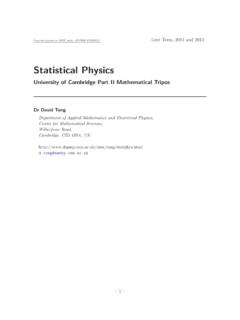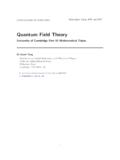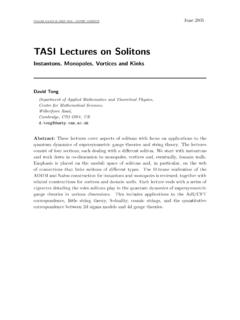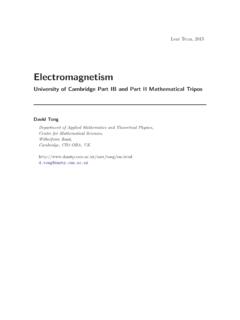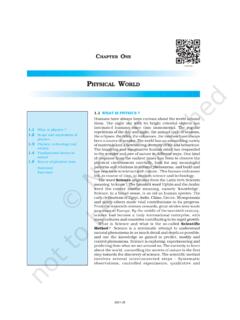Transcription of Statistical Physics - DAMTP
1 Preprint typeset in JHEP style - HYPER VERSIONLent Term, 2011 and 2012 Statistical PhysicsUniversity of Cambridge Part II Mathematical TriposDr David TongDepartment of Applied Mathematics and Theoretical Physics ,Centre for Mathematical Sciences,Wilberforce Road,Cambridge, CB3 OBA, 1 Recommended Books and Resources Reif,Fundamentals of Statistical and Thermal PhysicsA comprehensive and detailed account of the subject. It s solid. It s good. It isn tquirky. Kardar, Statistical Physics of ParticlesA modern view on the subject which offers many insights. It s superbly written, if alittle brief in places. A companion volume, The Statistical Physics of Fields coversaspects of critical phenomena. Both are available to download as lecture notes. Linksare given on the course webpage Landau and Lifshitz, Statistical PhysicsRussian style: terse, encyclopedic, magnificent.
2 Much of this book comes across asremarkably modern given that it was first published in 1958. Mandl, Statistical PhysicsThis is an easy going book with very clear explanations but doesn t go into as muchdetail as we will need for this course. If you re struggling to understand the basics,this is an excellent place to look. If you re after a detailed account of more advancedaspects, you should probably turn to one of the books above. Pippard,The Elements of classical ThermodynamicsThis beautiful little book walks you through the rather subtle logic of classical ther-modynamics. It s very well done. If Arnold Sommerfeld had read this book, he wouldhave understood thermodynamics the first time are many other excellent books on this subject, often with different empha-sis. I recommend States of Matter by David Goodstein which covers several topicsbeyond the scope of this course but offers many insights.
3 For an entertaining yet tech-nical account of thermodynamics that lies somewhere between a textbook and popularscience, read The Four Laws by Peter number of good lecture notes are available on the web. Links can be found on thecourse webpage: 2 Contents1. The Fundamentals of Statistical Microcanonical and the Second Law of Example: The Two State , Volume and the First Law of Boltzmann (1844-1906) Canonical Partition and Chemical Canonical Canonical and Intensive Willard Gibbs (1839-1903)302. classical classical Partition Quantum to of Sociological Meaning of Boltzmann s and Gibbs s Ideal Gas in the Grand Canonical History of Kinetic Mayer f Function and the Second Virial der Waals Equation of Cluster and the Debye-H uckel Model of a Plasma603. Quantum of : Blackbody Cosmic Microwave Background Birth of Quantum Planck (1858-1947) Debye Diatomic Gas High Temperature Quantum Gas is (Almost) Capacity: Our First Look at a Phase Fermi Fermi Gas and the Fermi Fermi Gas at Low More Rigorous Approach: The Sommerfeld Dwarfs and the Chandrasekhar Diamagnetism1044.
4 classical and the Zeroth First Second Carnot Temperature Scale and the Ideal History of Potentials: Free Energies and 1 s Third Law1335. Phase Clausius-Clapeyron Critical Ising Field of Mean Field Exact Results for the Ising Ising Model ind= 1 Ising Model: Low Temperatures and Peierls Ising Model: High Order Phase Order Phase 2 AcknowledgementsThese lecture notes are far from original. They borrow heavily both from the booksdescribed above and the online resources listed on the course webpage. I benefited a lotfrom the lectures by Mehran Kardar and by Chetan Nayak. This course is built on thefoundation of previous courses given in Cambridge by Ron Horgan and Matt am also grateful to Ray Goldstein for help in developing the present syllabus. I amsupported by the Royal Society and Alex Considine.
5 3 1. The Fundamentals of Statistical Mechanics Ludwig Boltzmann, who spent much of his life studying Statistical mechan-ics, died in 1906 by his own hand. Paul Ehrenfest, carrying on the work,died similarly in 1933. Now it is our turn to study Statistical mechanics. David IntroductionStatistical mechanics is the art of turning the microscopic laws of Physics into a de-scription of Nature on a macroscopic you ve got theoretical Physics cracked. Suppose you know all the funda-mental laws of Nature, the properties of the elementary particles and the forces at playbetween them. How can you turn this knowledge into an understanding of the worldaround us? More concretely, if I give you a box containing 1023particles and tell youtheir mass, their charge, their interactions, and so on, what can you tell me about thestuff in the box?There s one strategy that definitely won t work: writing down the Schr odinger equa-tion for 1023particles and solving it.
6 That s typically not possible for 23 particles,let alone 1023. What s more, even if you could find the wavefunction of the system,what would you do with it? The positions of individual particles are of little interestto anyone. We want answers to much more basic, almost childish, questions about thecontents of the box. Is it wet? Is it hot? What colour is it? Is the box in danger ofexploding? What happens if we squeeze it, pull it, heat it up? How can we begin toanswer these kind of questions starting from the fundamental laws of Physics ?The purpose of this course is to introduce the dictionary that allows you translatefrom the microscopic world where the laws of Nature are written to the everydaymacroscopic world that we re familiar with. This will allow us to begin to address verybasic questions about how matter ll see many examples.
7 For centuries from the 1600s to the 1900s scientistswere discovering laws of Physics that govern different substances. There are manyhundreds of these laws, mostly named after their discovers. Boyle s law and Charles slaw relate pressure, volume and temperature of gases (they are usually combined intothe ideal gas law); the Stefan-Boltzmann law tells you how much energy a hot objectemits; Wien s displacement law tells you the colour of that hot object; the Dulong-Petit 1 law tells you how much energy it takes to heat up a lump of stuff; Curie s law tellsyou how a magnet loses its magic if you put it over a flame; and so on and so on. Yetwe now know that these laws aren t fundamental. In some cases they follow simplyfrom Newtonian mechanics and a dose of Statistical thinking. In other cases, we needto throw quantum mechanics into the mix as well. But in all cases, we re going to seehow derive them from first large part of this course will be devoted to figuring out the interesting thingsthat happen when you throw 1023particles together.
8 One of the recurring themes willbe that 10236= 1. More is different: there are key concepts that are not visible inthe underlying laws of Physics but emerge only when we consider a large collection ofparticles. One very simple example is temperature. This is not a fundamental concept:it doesn t make sense to talk about the temperature of a single electron. But it wouldbe impossible to talk about Physics of the everyday world around us without mentionof temperature. This illustrates the fact that the language needed to describe physicson one scale is very different from that needed on other scales. We ll see several similaremergent quantities in this course, including the phenomenon of phase transitions wherethe smooth continuous laws of Physics conspire to give abrupt, discontinuous changesin the structure of , the techniques of Statistical mechanics proved to be a crucial tool forunderstanding the deeper laws of Physics .
9 Not only is the development of the subjectintimately tied with the first evidence for the existence of atoms, but quantum me-chanics itself was discovered by applying Statistical methods to decipher the spectrumof light emitted from hot objects. (We will study this derivation in Section 3). How-ever, Physics is not a finished subject. There are many important systems in Nature from high temperature superconductors to black holes which are not yet understoodat a fundamental level. The information that we have about these systems concernstheir macroscopic properties and our goal is to use these scant clues to deconstruct theunderlying mechanisms at work. The tools that we will develop in this course will becrucial in this The Microcanonical Ensemble Anyone who wants to analyze the properties of matter in a real problemmight want to start by writing down the fundamental equations and thentry to solve them mathematically.
10 Although there are people who try touse such an approach, these people are the failures in this field.. Richard Feynman, sugar coating it. 2 We ll start by considering an isolated system with fixed energy,E. For the purposesof the discussion we will describe our system using the language of quantum mechanics,although we should keep in mind that nearly everything applies equally well to your first two courses on quantum mechanics you looked only at systems with afew degrees of freedom. These are defined by a Hamiltonian, H, and the goal is usuallyto solve the time independent Schr odinger equation H| =E| In this course, we will still look at systems that are defined by a Hamiltonian, but nowwith a very large number of degrees of freedom, sayN 1023. The energy eigenstates| are very complicated objects since they contain information about what each ofthese particles is doing.
